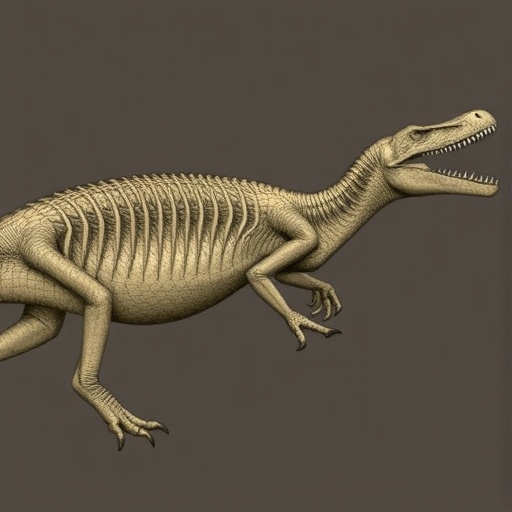In a groundbreaking discovery poised to reshape our understanding of reptile evolution, researchers have unveiled the oldest known lepidosaur—a key group that includes modern lizards, snakes, and the enigmatic tuatara. Unearthed from the Middle Triassic Otter Sandstone of Devon, UK, this remarkably preserved specimen not only rewrites the timeline for lepidosaur origins but also sheds unprecedented light on the early adaptations that enabled this diverse lineage to thrive for over two hundred million years.
The Otter Sandstone, a geological formation long recognized for its rich repository of Triassic fossils, has now yielded an extraordinary find. Traditionally assigned to the Helsby Sandstone Formation within the Sherwood Sandstone Group, this sedimentary sequence dates back approximately 242 million years, at the cusp of the Anisian-Ladinian boundary. The formation reveals a narrative of rivers meandering through semi-arid landscapes, where fossils of freshwater fishes, diverse amphibians, and early reptiles have languished for eons within reddish sandstones and mudstones.
It was within a slender, delicate bed of fine-grained sandstone, scarcely a few centimeters thick and located near the formation’s upper layers, that the nearly complete skeleton and skull of this ancient rhynchocephalian lepidosaur emerged. Recovered in 2015 from a foreshore exposure near Sidmouth, east Devon, the specimen was encapsulated within a block measuring just over ten by twelve centimeters, harking back to a scene from deep time when a catastrophic flood event rapidly entombed a vibrant ecosystem teeming with small reptiles and fishes.
The exceptional preservation state of the BRSUG 29950-14 specimen, as catalogued by the University of Bristol’s School of Earth Sciences, accentuates the stunning detail visible in its skeletal elements. Subtle weathering had partially exposed its dorsal skull margins and vertebral column, but cutting-edge imaging technologies were imperative to unlock its secrets. Employing a combination of X-ray computed tomography and synchrotron microcomputed tomography, the research team generated ultra-high-resolution, three-dimensional models of the skull and skeleton, revealing intricate anatomical features including delicate teeth and palatal bones.
These imaging advancements had a transformative impact on the morphological analysis of the specimen. In preparing the data, the scientists utilized the Avizo and Dragonfly software suites to render the fossil in digital form, allowing precise measurement and manipulation invisible to traditional approaches. Notably, the phase-contrast synchrotron scanning at the ESRF beamline facilitated a voxel resolution of six micrometers, providing an unparalleled window into this Middle Triassic reptilian marvel with clarity previously unattainable.
The fossil’s preservation context hints at a sudden depositional event, possibly triggered by a violent rainstorm causing a nearby river channel to burst its banks and cascade onto a ponded bar surface. This scenario explains the co-occurrence of well-articulated fish and small reptile fossils, suggesting minimal post-mortem transport and an ecological snapshot frozen in the sandstone. The rapid burial conditions likely played a crucial role in maintaining not only skeletal integrity but also the relative positioning of bones that informed phylogenetic interpretations.
Unraveling where this specimen fits in the reptilian family tree necessitated thorough comparative analyses across a vast morphological dataset encompassing hundreds of traits and taxa. One matrix, incorporating 383 morphological features from 127 taxa, including both early diapsids and archosaurs, enabled the researchers to decisively place the specimen within Lepidosauria. This approach was refined by applying a strict topological constraint derived from recent molecular data to balance historical discrepancies between morphology-based and genetic phylogenies.
In this comprehensive phylogenetic framework, the specimen, described as Agriodontosaurus helsbypetrae, displays characteristics aligning it with early rhynchocephalians, a clade traditionally represented today only by the tuatara. The inclusion of new taxa and characters refined the evolutionary narrative, highlighting morphological innovations in skull architecture and dentition that are foundational to the lepidosaur success story. These adaptations include changes in jaw mechanics that underpin versatile feeding strategies.
Bayesian inference methods further enriched the analysis by incorporating fossil age calibrations to estimate divergence times within early lepidosaurs. By running extensive Markov chain Monte Carlo simulations under a fossilized birth–death model, the study produced a time-calibrated phylogeny that situates Lepidosauromorpha origins firmly in the Middle Triassic. This result reveals that the evolutionary experimentation leading to modern lepidosaur diversity began far earlier than previously appreciated.
The implications of unlocking the earliest lepidosaur and its feeding adaptations are profound. Lepidosaurs represent the most speciose group of modern reptiles, exhibiting remarkable ecological breadth and morphological disparity. Understanding how these traits emerged sheds light on one of Earth’s major vertebrate radiations. The evolutionary leap marked by Agriodontosaurus helsbypetrae serves as a tangible anchor point, bridging the gap between ancestral diapsid reptiles and the complex biologies that characterize today’s squamates.
Furthermore, the meticulous application of advanced imaging and phylogenetic methodologies exemplifies the cutting-edge intersection of paleontology and computational science. Deploying synchrotron facilities and powerful reconstruction software enables paleobiologists to peer beyond mere bones, discerning subtle morphological nuances that illuminate evolutionary relationships in remarkable detail. This approach heralds a new era of fossil analysis that goes beyond traditional descriptive taxonomy.
Crucially, the collaborative nature of this research underscores how integrating geological context, fossil preservation, and sophisticated analytical pipelines can revolutionize our understanding of deep time. Converging evidence from sedimentology, taphonomy, and morphology coalesced to reveal not just a single specimen, but a window into a transformative period when lepidosaur lineage began its ascent toward ecological dominance.
This discovery also revitalizes interest in the Middle Triassic terrestrial ecosystems of Europe, a critical but understudied interval that witnessed the diversification of many early reptilian groups in the wake of the Permian extinction. By revealing the presence of a stem lepidosaur in these deposits, the study challenges previous biogeographic hypotheses and invites reconsideration of how early reptiles dispersed and adapted to diverse paleoenvironments.
The intricate dance between evolutionary novelty and environmental dynamics emerges as a theme running through this work. The semi-arid fluvial landscapes preserved in the Otter Sandstone formed the stage upon which early reptiles navigated unpredictable climes, driving adaptations in locomotion, feeding, and reproduction. Agriodontosaurus helsbypetrae embodies this evolutionary response, showcasing traits that optimized survival in these challenging Triassic habitats.
Ultimately, this research not only rewrites the early history of lepidosaurs but fundamentally enriches the narrative of vertebrate evolution during the Triassic. By capturing a fossil moment embodying the dawn of a lineage that persists to this day, it reconnects present-day biodiversity with its deep past, illuminating the origins of traits crucial to modern reptiles’ ecological success. This remarkable finding sets the stage for future explorations into the evolutionary origins of one of the most diverse and fascinating groups of terrestrial vertebrates.
Subject of Research: Lepidosaur origins and early evolutionary adaptations based on a Middle Triassic fossil specimen from the Otter Sandstone, UK.
Article Title: The oldest known lepidosaur and origins of lepidosaur feeding adaptations.
Article References:
Marke, D., Whiteside, D.I., Sethapanichsakul, T. et al. The oldest known lepidosaur and origins of lepidosaur feeding adaptations. Nature (2025). https://doi.org/10.1038/s41586-025-09496-9
Image Credits: AI Generated
Tags: Devon UK fossil findingsearly reptile feeding adaptationsfossil preservation techniqueslepidosaur evolutionlizard and snake ancestorsoldest reptile fossil discoveryOtter Sandstone paleontologyprehistoric ecosystemsrhynchocephalian adaptationssedimentary rock formationsTriassic geological historyTriassic period reptiles





